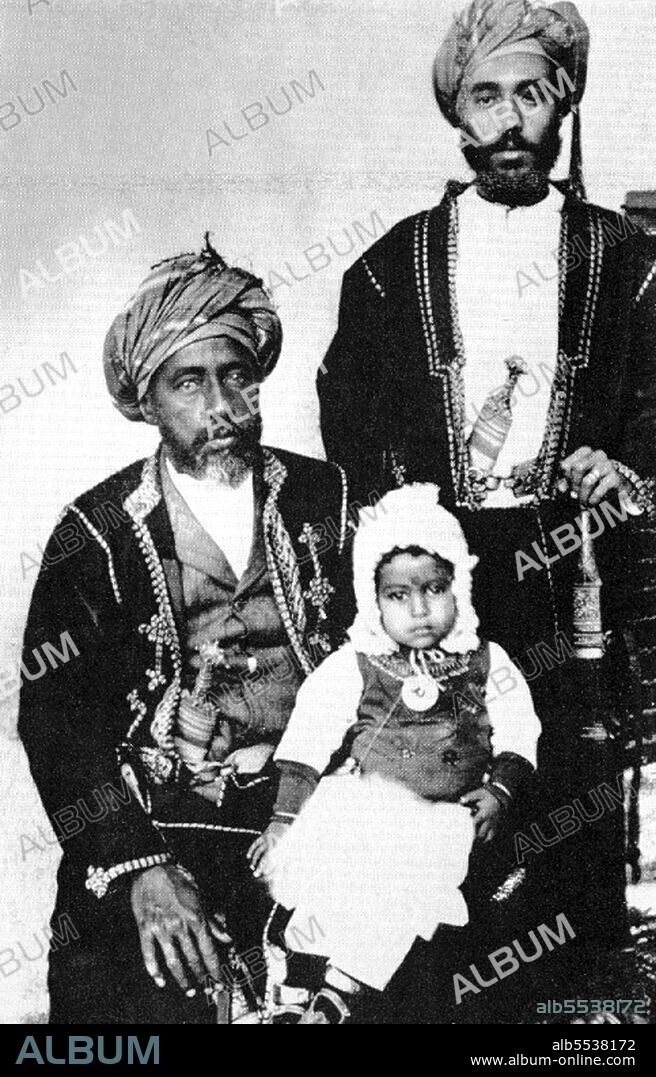alb5538172
Oman: Sultan Faisal bin Turki (r. 1888-1913) with his son Taimur bin Faisal and his grandson, Said bin Taimur c. 1913.

|
Add to another lightbox |
|
Add to another lightbox |



Title:
Oman: Sultan Faisal bin Turki (r. 1888-1913) with his son Taimur bin Faisal and his grandson, Said bin Taimur c. 1913.
Caption:
Sayyid Faisal bin Turki, GCIE (1864 – 4 October 1913) (Arabic: ????? ???? ?? ??????), historic spelling Fessul bin Turkee, ruled as Sultan of Muscat and Oman from 4 June 1888 – 4 October, 1913. He succeeded his father Turki bin Said as Sultan. Upon his death in 1913, he was succeeded by his eldest son Taimur bin Faisal. On assuming power in 1888, Faisal ibn Turki gradually found his authority over the interior weakened as tribal leaders increasingly perceived his dependence on British advisers as an inherent weakness. In 1895 he was forced to seek refuge at Jalali fort after Muscat was captured. British political agents frustrated his efforts to recapture Muscat, compelling him to court the French. He granted the French coaling facilities for their fleet at Bandar Jissah near Muscat. Determined to thwart any growth in French presence in what Britain considered its sphere of influence, Britain presented Faisal ibn Turki with an ultimatum in 1899 ordering the sultan to board the British flagship or Muscat would be bombarded. Having little recourse, Faisal ibn Turki capitulated. Publicly humiliated, his authority was irreversibly damaged. In 1903 he asked Lord George Nathaniel Curzon, viceroy of India, for permission to abdicate, but his request was denied. Responsibility for the capital was delegated to Said ibn Muhammad Al Said, while affairs of the interior fell to an ex-slave, Sulayman ibn Suwaylim. By 1913 control over the interior was completely lost, and a reconstituted imamate was again a threat to Muscat. In May 1913, Salim ibn Rashid al Kharusi was elected imam at Tanuf and spearheaded a revolt against the sultan that combined both Hinawi and Ghafiri tribal groups.
Credit:
Album / Pictures from History/Universal Images Group
Releases:
Model: No - Property: No
Rights questions?
Rights questions?
Image size:
3267 x 5100 px | 47.7 MB
Print size:
27.7 x 43.2 cm | 10.9 x 17.0 in (300 dpi)
Keywords:
ARABIA • ARABIAN SEA • ASIA PICTURES • ASIA • ASIAN IMAGE • ASIAN IMAGES • ASIAN PICTURES • ASIAN • HISTORIA UNIVERSAL • HISTORIA • HISTORICAL IMAGES • HISTORICAL PICTURES • HISTORICAL • HISTORY IMAGES • HISTORY PICTURES • HISTORY • INDIAN OCEAN • ISLAM • ISLAMISM • KING • MONARCH • MUSCAT AND OMAN • MUSCAT • MUSLIM WORLD • MUSLIM • OMAN • OMANI • RULER • SULTAN
 Pinterest
Pinterest Twitter
Twitter Facebook
Facebook Copy link
Copy link Email
Email

